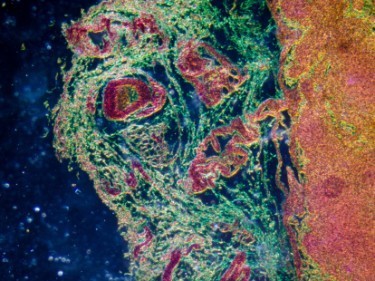How much do you know about lymphatic cancer? It’s the fifth most commonly diagnosed form of the disease, for starters. Hannah Stephenson finds out more
On average, every 40 minutes in the UK, somebody is diagnosed with lymphoma. This equates to around 14,000 people a year, making it the fifth most commonly diagnosed cancer, with some 100,000 currently living with it.
Despite these figures, lymphoma doesn’t fit the usual cancer profile, and it remains a bit of a mystery to many.”Lymphoma is a complex disease that challenges people’s everyday perceptions of what cancer is,” says Jonathan Pearce, chief executive of the Lymphoma Association, the charity behind Lymphatic Cancer Awareness Week (Sep 14-20). “It does not present as a solid tumour in a specific site that can be diagnosed and treated quickly.”
Instead, lymphoma affects the lymphatic system, part of the body that few people really know or understand – but because it’s relatively common, awareness is vital.
“While being a cancer that generally presents in older age, it is also the most common cancer in people aged under 30,” Pearce adds. “Anyone experiencing the signs and symptoms of lymphoma should visit their GP.”
WHAT IS LYMPHOMA?
There are different types of lymphoma. When a person has lymphoma, some of their lymphocytes (types of white blood cells) are out of control – they divide in an abnormal way or do not die off when they should, and can form tumours which collect in the lymph nodes (small glands in different areas of the body where lymphocytes are formed – you might sometimes feel them in your groin, neck and armpit). Lymphoma can affect lymph nodes in all parts of the body and can also involve other organs/areas, such as the spleen, bone marrow, stomach, skin or liver.
TYPES OF LYMPHOMA
“There are many types of lymphoma. Some grow quickly and are ‘aggressive’. Others grow slowly and are treated more like a chronic condition, following a remitting and relapsing pattern. People can live with ‘chronic’ lymphoma for a long time,” says Pearce.
Further tests will determine what type somebody has:
Hodgkin lymphoma
This is diagnosed if a particular cell is present (called the Reed-Sternberg cell) and is more common in people aged 15-35 or 55 and over. It affects more men than women and can now be successfully treated, with the majority of people diagnosed being completely cured. Around 1,800 people are diagnosed with Hodgkin lymphoma every year in the UK.
Non-Hodgkin lymphoma
This type (NHL) is more common in people aged over 55 and is one of the most common cancers affecting the over-75s. Around 12,000 people are diagnosed with non-Hodgkin lymphoma every year in the UK.
NHL is divided into two sub-types: High grade NHL, most common in people over 50, is where the cells appear to be dividing quite quickly; in many cases, this can be cured, and low grade NHL, where the cells appear to divide slowly and which can take a long time to develop. With this form of the disease, most people have advanced cancer by the time they are diagnosed, and due to the chronic nature of low grade NHL, doctors generally aim to control it rather than cure it.
SIGNS AND SYMPTOMS
Some people with lymphoma may experience a wide range of symptoms, while others will notice none at all. The most common symptom is a painless lump or swelling, often in the neck, armpit or groin (though remember this doesn’t always indicate cancer and it’s very common for lymph nodes to swell when you’re under the weather or have a non-serious infection – though it is always very important to get unusual lumps and swelling checked out as soon as possible). According to the Lymphoma Association, other symptoms include excessive sweating – especially at night – fevers, unexplained weight loss, unusual tiredness, a cough or breathlessness, persistent itch, abdominal pain or diarrhoea.
TREATMENT
This depends on the type of lymphoma somebody is diagnosed with, but may involve chemotherapy, radiotherapy and stem cell transplants. “Lymphatic cancer is neither well-known nor easily understood and patients will have differing needs,” adds Pearce. “This makes our work to raise awareness of lymphoma and ensure future cancer policies and initiatives accommodate lymphatic cancers – in the same way that attention is given to the top four cancers [breast, bowel, lung and prostate] – vital.”
For further information, visit www.lymphomas.org.uk

